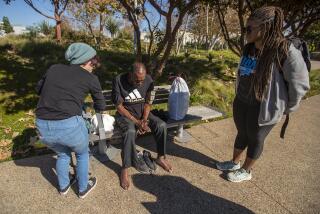Housing rules for sex offenders come under scrutiny
- Share via
WEST PALM BEACH, FLA. — The dozen men who gather every Monday night in a nondescript West Palm Beach office building -- including a 36-year-old machinist, a 59-year-old engineer, a 45-year-old handyman -- share a common label: registered sex offender.
Most go to mental health counselor Ben Taylor’s weekly 90-minute sessions as part of court-ordered therapy.
But talk frequently turns to the hodgepodge of residency restrictions for sex offenders.
A financial analyst, 47, and his wife recently bought a home after months of looking. In 2002, the man tried to solicit a 14-year-old girl online. It was a police officer. He pleaded guilty and received 10 years probation. “A lot of houses we could afford to buy,” he said, “but I couldn’t live in them because I couldn’t get approval” from his probation officer.
Florida law prohibits people convicted on or after Oct. 1, 2004, from living within 1,000 feet of any school, day-care center, park and playground.
In 2006, Palm Beach County enacted its own law with a 2,500-foot restriction. And 15 of the county’s municipalities have their own laws.
State Sen. Dave Aronberg proposed a bill in the last legislative session that would create a statewide 1,500-foot rule. The bill would also require a 24-hour child protection zone and ban loitering around schools, parks and libraries.
Aronberg’s bill was blocked by legislators from Miami-Dade County who said it would weaken that county’s 2,500-foot law, he said.
Aronberg said the myriad municipal regulations had created a homeless sex-offender population.
Jill Levenson, an associate professor of human services at Lynn University in Boca Raton, agrees. “Residency restrictions sound good in theory and are very well-intended but they don’t really address the most common types of situations children are abused in,” she said. “Children are much more likely to be sexually abused by someone they know and trust.”
By making it harder to find housing, the restrictions contribute to transience, homelessness and instability, all of which are associated with an increased risk of offending again, Levenson said.
Taylor agrees. “When they are pushed out of the community, they often go back to bad behaviors,” he said.
More to Read
Sign up for Essential California
The most important California stories and recommendations in your inbox every morning.
You may occasionally receive promotional content from the Los Angeles Times.













